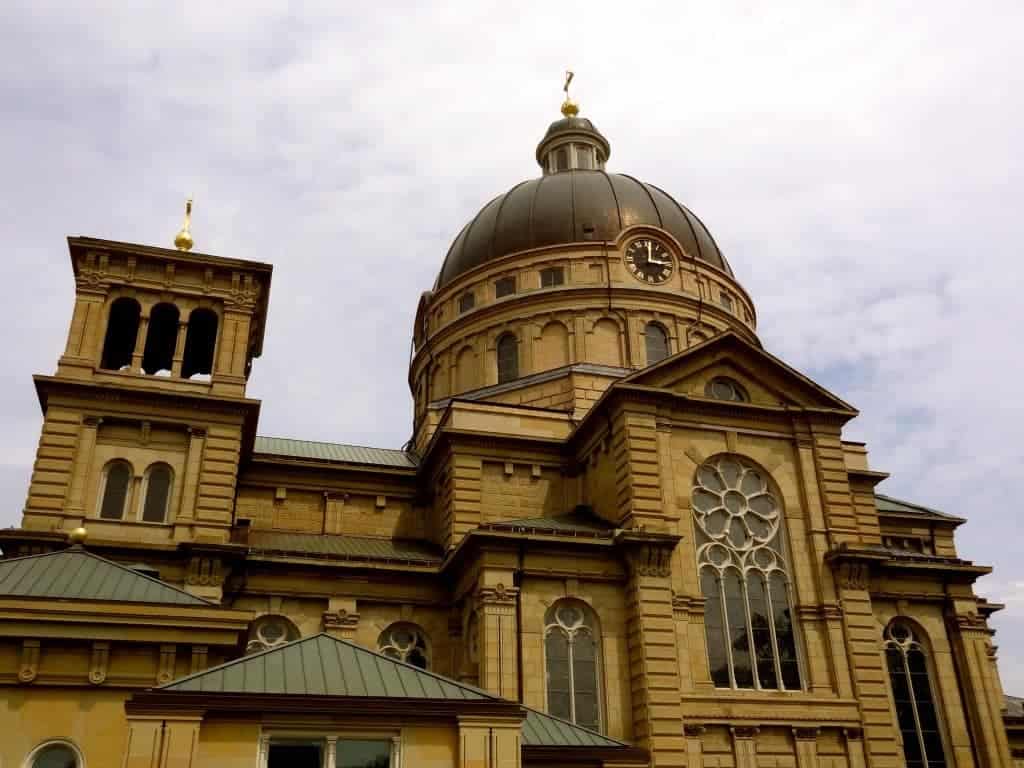It’s November and a very long winter is on the way. It’s two weeks after payday and the account is dry. The car needs work. Mourning and weeping is all well and good, but shouldn’t you be allowed — just for a moment, once in a while — to look into Eden?
That’s when you go to Saint Josaphat.
Get on 94 and exit at Lincoln Avenue. Head west for a few blocks past the duplexes with tarpaper shingles, past the Serbian restaurant and Nail Sensations. Park somewhere on the street, maybe in front of the locksmith. There isn’t even a parking meter. Cross the street and get yourself up the steps and through the door, pushing on the handle marked with the seal of the US Customs Service (we’ll explain later). Let the door close behind you. Exhale. Heaven.
Saint Josaphat: an angel holds the holy water font. The walls vibrate with sconces and scrollwork and trompe l’oeil marble. A slick stone floor stretches to the main altar, 50 yards away. Beyond the baldachin, in vivid oils, a bishop in red is ready to feel the axe.
Look up: a blank dome broods 250 feet above the street, but here on the inside it buzzes with life. Apostles. Fathers of the Church. Celestial bodies. Eight windows with eight different Madonnas. Giant canvasses that follow Raphael’s. And, in gold letters around the base, this verse from the First Book of Kings: “I have hallowed this house, which thou hast built, to put my name there for ever; and mine eyes and mine heart shall be there perpetually.” Except it’s in Polish. Because Poles built this place. “Bom obrał i poświęcił to miejsce, aby tam imię moje było na wieki, a żeby tam trwały oczy moje i serce moje po wszystkie dni.” Take that, uvula! Assimilated they weren’t.
Here prayed the Poles who clung to a South Side as unglamorous then as it is now. Poles who, some of them, could barely read in their own language much less in English. Poles who emigrated “za chlebem” — for bread, as the title of a sentimental novella by Sienkiewicz put it — and ended up in Chicago or Pittsburgh or Buffalo or Milwaukee bending over a blast furnace or tanner’s vat while their wives put their knees on the floorboards and their fingers in some lady’s washbucket.
These same Poles built a basilica. They built it. Because they could not give money, they gave work. The washerwoman came home, made the children something to eat, then shifted debris from the foundations of the edifice, one basketful or apron-load at a time. Her husband drove the horse that hauled the sledge that carried the dirt to the dump site west of the Kinnickinnic. Her brother hustled blocks up the scaffold. And so it went, for years.
They didn’t have money for materials, either. But they did have a wily pastor named Grutza. He sensed an opportunity when a new federal building in Chicago was brought down for structural flaws. He snapped up the cast-off sandstone and fittings for pennies and shipped it all to Milwaukee on flatcars. An architect from Wuerttemberg (by way of Ohio) was engaged to magic the stones into place. The Postal Service’s brass railings were hoisted to the choir and the Customs Service’s shield stayed on the doorknobs. Soon the archbishop was gliding through to celebrate High Mass. It was 1901.
Five weeks after the dedication, Father Wilhelm Grutza, who had overseen the building process from start to finish, expired. We hope he ended up with Josaphat.
Go there on a Sunday now. They have one of the best choirs in town. The organ throbs and thickens the air into honey. Ladies in fur coats who’ve come in from the suburbs — some, the granddaughters of washerwomen — sit next to Mexican maids in nylon jackets. And after the Sanctus they’re all on their knees. Because this place is holy, hallowed by God, and from time to time, just for a moment, God’s people need to stop in and see Him.
View the rest of CCC’s Saint Josaphat gallery here.






